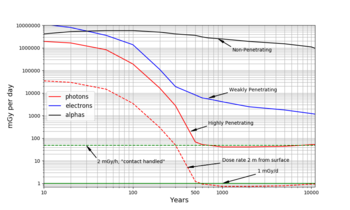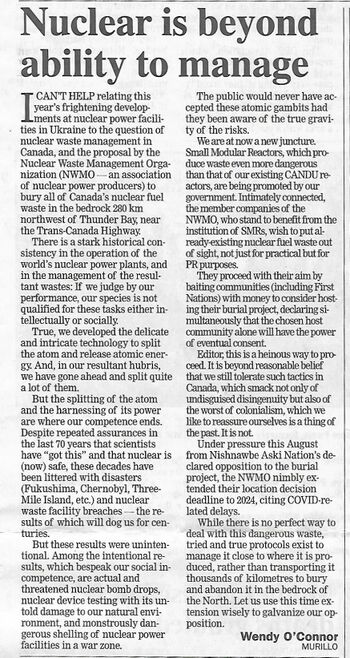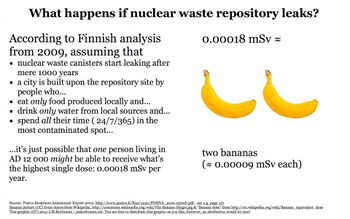Talk:Nuclear waste management: Difference between revisions
No edit summary Tag: Manual revert |
(Undo revision 872996 by David MacQuigg (talk)) Tag: Undo |
||
| Line 1: | Line 1: | ||
{{subpages}} | {{subpages}} | ||
{{TOC|right}} | {{TOC|right}} | ||
= A more realistic view of nuclear waste hazards = | |||
{{Image|Dose Rate at Fuel Element Surface.png|right|350px|Fig.3 Dose Rate at Fuel Element Surface.}} | |||
Figure 1 in the article exaggerates the long term danger of spent nuclear fuel. | |||
Long term radioactivity is mostly harmless alpha particles and electrons. The more dangerous gamma rays die out quickly.<br> | |||
To understand the nuclear waste problem, we must understand the difference between the three | |||
forms of radiation emitted by the used fuel: alpha particles, electrons, and photons (often called | |||
gamma rays). Alpha particles have no penetrating power. They are stopped by a piece of | |||
paper or a few centimeters of air. Electrons (confusingly called beta rays in this context) have | |||
very little penetrating power. Most are stopped by the outer layer of our skin. Alpha particles | |||
and electrons must be swallowed to be a health hazard. Photons on the other hand can have | |||
enormous penetrating power. High energy photons can pass all the way through a human being. | |||
Fresh used fuel puts out a lot of high energy photons and needs lots of shielding.<br> | |||
Dose is the amount of radiation energy absorbed by our tissue. Dose is measured in joules | |||
per kg of tissue. Gray is a shorthand name for joules per kg. Figure 3 is in milligrays per day | |||
(mGy/d). The key feature of Figure 3 is that photon decay is relatively rapid. By year 600, | |||
almost all the photon emitters are gone. In fact, the photon dose rate is so low that, according | |||
to DOE rules, the used fuel elements can be contact handled, handled without any shielding at | |||
all. After year 600, the spent nuclear fuel must be swallowed in order to do any damage.<br> | |||
--- Statement from Jack Devanney, Principle Engineer, ThorCon USA Inc. | |||
{{Image|Wendy O'Connor 300969813 169454332331742 3121472701817636302 n.jpg|right|350px|Fig.1 [https://www.facebook.com/NoNuclearWasteInNWO/posts/pfbid02xuZme5k3b8rkkgjBPSPbzzo4GjKEAV2xsZwpU2FpkSrLg5wTzL8SzDtuTMiSqfXQl Article] in the Chronical Journal by [[Wendy_O%27Connor]] 3 Sept 2022}} | {{Image|Wendy O'Connor 300969813 169454332331742 3121472701817636302 n.jpg|right|350px|Fig.1 [https://www.facebook.com/NoNuclearWasteInNWO/posts/pfbid02xuZme5k3b8rkkgjBPSPbzzo4GjKEAV2xsZwpU2FpkSrLg5wTzL8SzDtuTMiSqfXQl Article] in the Chronical Journal by [[Wendy_O%27Connor]] 3 Sept 2022}} | ||
=Nuclear Waste is Unmanageable= | =Nuclear Waste is Unmanageable= | ||
Revision as of 20:16, 14 September 2022
A more realistic view of nuclear waste hazards
Figure 1 in the article exaggerates the long term danger of spent nuclear fuel.
Long term radioactivity is mostly harmless alpha particles and electrons. The more dangerous gamma rays die out quickly.
To understand the nuclear waste problem, we must understand the difference between the three
forms of radiation emitted by the used fuel: alpha particles, electrons, and photons (often called
gamma rays). Alpha particles have no penetrating power. They are stopped by a piece of
paper or a few centimeters of air. Electrons (confusingly called beta rays in this context) have
very little penetrating power. Most are stopped by the outer layer of our skin. Alpha particles
and electrons must be swallowed to be a health hazard. Photons on the other hand can have
enormous penetrating power. High energy photons can pass all the way through a human being.
Fresh used fuel puts out a lot of high energy photons and needs lots of shielding.
Dose is the amount of radiation energy absorbed by our tissue. Dose is measured in joules
per kg of tissue. Gray is a shorthand name for joules per kg. Figure 3 is in milligrays per day
(mGy/d). The key feature of Figure 3 is that photon decay is relatively rapid. By year 600,
almost all the photon emitters are gone. In fact, the photon dose rate is so low that, according
to DOE rules, the used fuel elements can be contact handled, handled without any shielding at
all. After year 600, the spent nuclear fuel must be swallowed in order to do any damage.
--- Statement from Jack Devanney, Principle Engineer, ThorCon USA Inc.
Nuclear Waste is Unmanageable
From Nuclear Reader, Ch.8 Radioactive Waste:
"there is no plan for long term storage of radioactive waste."
Response:
Pending review. Let's distill the facts and rational argument from all the passion and attacks.
From the Chronical Journal:
"Nuclear is beyond ability to manage" see Fig.1
Response:
From Al Scott 4 Sept 2022, commenting in the FaceBook forum No Nuclear Waste in Northwestern Ontario
""
The article makes nebulous reference to unnamed waste facility breaches as though this were a thing that has happened. Shame.
Despite this fabrication the article is well crafted to attempt to taint civilian nuclear power with the evils of nuclear weapons. This despite the fact that the megatons to megawatts program burned Soviet nuclear warheads for clean energy—nuclear reactors are the only way to permanently get rid of enriched weapons grade plutonium.
It attempts to evoke fear with reference to industrial accidents at Three mile island and Fukushima that caused more damage due to unfounded panic, than by the meagre effects of low level radiation. Nobody was killed by radiation despite Fukushima being arguably a worst case situation with a magnitude 9 earthquake and a colossal 40 metre tsunami. This ignores the fact that nearby nuclear facilities survived and even saved lives by sheltering hundreds of local residents against the wave.
As always it falls on Chernobyl to do the heavy lifting of demonizing humanity’s best chance to avoid disastrous climate change. Chernobyl, the pristine wildlife reserve referred to as a desolate wasteland by opponents. Chernobyl, the only ‘civilian’ nuclear reactor disaster ever to result in radiation deaths (probably less than 100 based on decades of scientific study). Chernobyl with a tragic casualty list similar in size to a jet plane crash but with truly devastating impact to humanity—accelerating climate change due to well funded anti nuclear fear mongering.
Radiation is a low risk carcinogen. We have evolved to exist in a naturally radioactive environment. Living in the most radioactive places on earth doesn’t measurably increase your risk of cancer. Scientists are still debating whether low levels of radiation may actually extend life expectancies. Many people still seek out old uranium mines and radioactive hot springs for their purported health benefits (many scientific papers on hormesis).
Spreading fear of radiation is irresponsible rhetoric and results in increased fossil fuel use which kills millions of people worldwide and promises to devastate ecosystems.
""
Here is a graphic illustration of what might happen if there is a leak from a Nuclear Waste Repository. See Fig.2
Risk of Leaking Canisters
From the San Onofre Safety Website:
https://sanonofresafety.org/holtec-hi-storm-umax-nuclear-waste-dry-storage-system/
“Holtec HI-STORM UMAX canister storage systems and all other thin-wall nuclear waste canister storage systems are vulnerable to short-term cracking, radioactive leaks and potential explosions and criticalities.“
“Holtec Umax lids at San Onofre - Radioactivity at air vent (e.g., carbon-14) was 324 CPMs”
“A canister breach in Texas or New Mexico can impact the water supply for eight states (the Ogallala aquifer), the breadbasket of the U.S.”
Holtec canisters:
Cannot be inspected inside or out
Cannot be repaired
Cannot be monitored or maintained to PREVENT radioactive leaks
No plan for failing canisters
From Holtec website: https://holtecinternational.com/products-and-services/hi-store-cis/overview/
“The life expectancy of the stainless-steel canister, which is the primary containment of the spent nuclear fuel, varies based on the environment. Conservative estimates put the life expectancy of the canister at hundreds of years. As part of the aging management program, there are regular inspections of canisters that will check the entire surface of a single canister, or part of the surface of multiple canisters. If these inspections would ever indicate an imperfection or crack, canisters would be re-packaged before a crack could propagate and a leak occur. There is sufficient time to re-package the canister since it would take many years for a crack to develop into a leak.”
“There are no liquid effluents or radioactive gas produced by the HI-STORE CIS facility. Therefore, there is no risk to the local groundwater or the quality of air at the site.”
“The HI-STORE CIS facility occupies less than the top 30 feet of the earth’s crust. Industrial activities such as mining of potash or extraction of hydrocarbons from the land, which occurs >1000 feet below-the-surface, will be entirely unaffected by the HI-STORE installation.“
Non-fuel waste
Question in the FaceBook group Renewable vs Nuclear
"all the stuff on the primary loop. Pipes, pumps, wiring, blah blah. Obviously there is going to be mechanical and chemical wear on parts and they will need to be replaced like any power plant relying on heat -> steam -> turbine -> generator process. Parts will be be additionally exposed to neutrons and presumably undergo nuclear reactions and I assume some of those reactions will compromise their mechanical properties... eventually. How big of a deal is this? Is it slow, fast? What is the balance of fuel waste to non-fuel waste? Where do these parts go?"
Answer from Captain Roger Blomquist, United States Navy (retired) 8 Feb 2022:
"There are small concentrations of activated structural elements like cobalt. These typically have half-lives of years, not multiple decades. If they are recycled, then the workers doing the recycling will need to take (sometimes expensive) precautions to minimize their radiation exposure. I doubt that any such exposures would be harmful, although some might be. The precautions are quite likely far in excess of what is needed to prevent actual health effects."
Answer: from World Nuclear Association Recycling and reuse of materials from decommissioning
Recycling materials from decommissioned nuclear facilities is constrained by the level of radioactivity in them. This is also true for materials from elsewhere, such as gas plants, but the levels specified can be very different. For example, scrap steel from gas plants may be recycled if it has less than 500,000 Bq/kg radioactivity. This level however is one thousand times higher than the clearance level for recycled material from the nuclear industry, where generally anything above 500 Bq/kg may not be cleared from regulatory control for recycling.
Question on Quora.com
How big a problem is irradiated steel and other non-fuel waste from a nuclear power plant?
Answer: from World Nuclear Association discussion of Recycling and reuse of materials from decommissioning:
Decommissioned steam generators from Bruce Power in Canada
"These steam generators were each 12m long and 2.5m diameter, with mass 100 tonnes, and contained some 4g of radionuclides with about 340 GBq of activity. Exposure was 0.08 mSv/hr at one metre." This compares to a chest x-ray (0.020 mSv) or the minimum exposure to show a measurable increase in cancer risk (100 mSv) XKCD Radiation Chart
Answer from Lyle McElhaney 30 March 2022:
Iron is an element that is difficult to make radioactive.
This table shows that iron-56, which is almost 92% of all naturally occurring iron, requires three neutron absorptions before it becomes radioactive, and two absorptions for another 2% of the material. A single absorption is a low probability event for any given iron nucleus; absorbing three is a low probability to the third power. If it does happen, it results in iron-59 which beta decays to cobalt-59 (stable) with a half-life of 45 days.
Of course, it also shows that about 6% of iron will become unstable with the absorption of a single neutron. The resulting isotope decays by electron capture, which does not emit a particle other than a neutrino, and results in manganese-55, which is stable. So, no harm done by that other than possibly some gamma-rays.
The cobalt-59 resulting from a triple neutron capture could catch another neutron, becoming the dreaded cobalt-60, nemesis of the cobalt bomb. Cobalt-60 has a powerful gamma-ray emission as it beta decays with a half-life of around 5 years. This requires, as noted, 4 successive neutron captures with an intervening beta decay after the third. It is a very small probability event in concept; I don’t know what it is in practice.
Other materials - some do become radioactive when drenched with neutrons for an extended time. One would need to know what materials to analyze what happens.
Answer from Joe Waligora, Wrote the SNF transfer to dry storage training program, taught SNF transfer to field supervisors and union crews; led an SNF transfer crew.
On the handling of irradiated metal during decommissioning of large nuclear power plants:
Siempelkamp Nuclear Services Inc. was contracted at Zion to perform segmentation of the reactor vessel and internals. This work was done with the reactor cavity flooded. GTCC (Greater Than Class C waste) was loaded into transportable storage cask (TSC) liners under water by transfer crews. Loaded TSCs were removed from the water in a shielded transfer cask after the TSC lid was installed. TSC was then dewatered enough to weld the lid on, then dewatered completely, vacuum dried, and backfilled with helium for corrosion control. TSC was then transferred from the transfer cask to the concrete storage cask and placed at the Independent Spent Fuel Storage Installation (ISFSI). There are two casks of GTCC from each reactor stored at the ISFSI in the same designed and licensed cask as the fuel. Workers were protected from over exposure to radiation by strict compliance to procedures, and continual monitoring by radiation protection personnel.
EPRI has experience and technical reports on segmentation and packaging of reactor vessel internals that can be found on their website.
- Article with Definition
- Engineering Category Check
- Physics Category Check
- Chemistry Category Check
- Developing Articles
- Nonstub Articles
- Internal Articles
- Engineering Developing Articles
- Engineering Nonstub Articles
- Engineering Internal Articles
- Physics Developing Articles
- Physics Nonstub Articles
- Physics Internal Articles
- Chemistry Developing Articles
- Chemistry Nonstub Articles
- Chemistry Internal Articles
- Engineering Underlinked Articles
- Underlinked Articles
- Physics Underlinked Articles
- Chemistry Underlinked Articles



